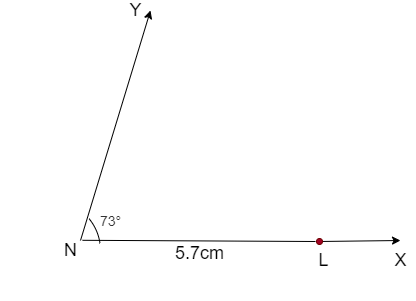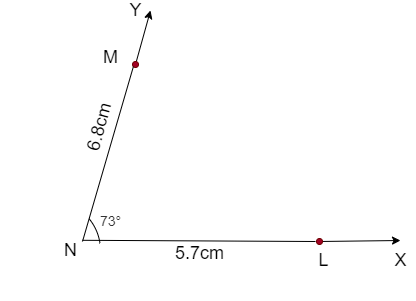
Construct a triangle \[\Delta LMN\] in which \[\angle N={{73}^{\circ }}\], \[LN=5.7cm\] and \[MN=6.8cm\]
Answer
552.9k+ views
Hint: We construct the required triangle by using the protractor and ruler.
We follow steps from the construction of the angle of the given triangle first and then we point the other vertices by using the given side lengths of the triangle.
Then we join the vertices to form the complete triangle.
Complete step by step answer:
We are asked to construct the triangle \[\Delta LMN\]
We are given that \[\angle N={{73}^{\circ }}\], \[LN=5.7cm\] and \[MN=6.8cm\]
Now, let us follow the steps from the construction of angle to sides and then a complete triangle.
Let us construct an angle \[\angle N={{73}^{\circ }}\] by using the rays NX and NY and protractor then we get

Now, let us point the vertex L on the ray NX such that \[LN=5.7cm\] by using the ruler then we get

Similarly, let us point the vertex M on the ray NY such that \[MN=6.8cm\] by using the ruler then we get

Now, let us join the vertices M and N then we get
Now, by removing the extra parts that is extra rays in the above figure we get

Now, by removing the extra parts that is extra rays in the above figure we get

Therefore we can conclude that the required triangle \[\Delta LMN\] has been constructed.
Note:
Students may make mistakes in taking the order of the construction.
We follow the order of first constructing the angle using the rays and then we point the other vertices to form the complete triangle.
We cannot for the perfect triangle by constructing the sides first because we do not know that how to arrange the sides to form the given angle of \[\angle N={{73}^{\circ }}\]
So, we construct the angle first and then followed by sides.
We follow steps from the construction of the angle of the given triangle first and then we point the other vertices by using the given side lengths of the triangle.
Then we join the vertices to form the complete triangle.
Complete step by step answer:
We are asked to construct the triangle \[\Delta LMN\]
We are given that \[\angle N={{73}^{\circ }}\], \[LN=5.7cm\] and \[MN=6.8cm\]
Now, let us follow the steps from the construction of angle to sides and then a complete triangle.
Let us construct an angle \[\angle N={{73}^{\circ }}\] by using the rays NX and NY and protractor then we get

Now, let us point the vertex L on the ray NX such that \[LN=5.7cm\] by using the ruler then we get

Similarly, let us point the vertex M on the ray NY such that \[MN=6.8cm\] by using the ruler then we get

Now, let us join the vertices M and N then we get
Now, by removing the extra parts that is extra rays in the above figure we get

Now, by removing the extra parts that is extra rays in the above figure we get

Therefore we can conclude that the required triangle \[\Delta LMN\] has been constructed.
Note:
Students may make mistakes in taking the order of the construction.
We follow the order of first constructing the angle using the rays and then we point the other vertices to form the complete triangle.
We cannot for the perfect triangle by constructing the sides first because we do not know that how to arrange the sides to form the given angle of \[\angle N={{73}^{\circ }}\]
So, we construct the angle first and then followed by sides.
Recently Updated Pages
Master Class 12 Business Studies: Engaging Questions & Answers for Success

Master Class 12 Economics: Engaging Questions & Answers for Success

Master Class 12 English: Engaging Questions & Answers for Success

Master Class 12 Maths: Engaging Questions & Answers for Success

Master Class 12 Social Science: Engaging Questions & Answers for Success

Master Class 12 Chemistry: Engaging Questions & Answers for Success

Trending doubts
Write a letter to the principal requesting him to grant class 10 english CBSE

Why is there a time difference of about 5 hours between class 10 social science CBSE

What is the median of the first 10 natural numbers class 10 maths CBSE

The Equation xxx + 2 is Satisfied when x is Equal to Class 10 Maths

Discuss the main reasons for poverty in India

10 examples of evaporation in daily life with explanations




